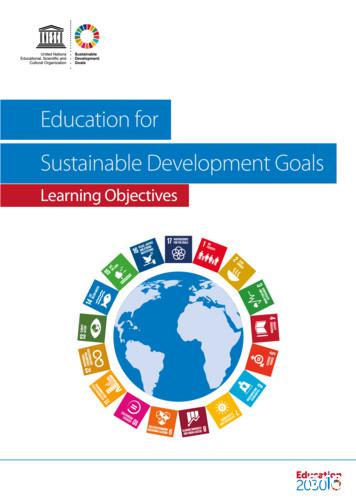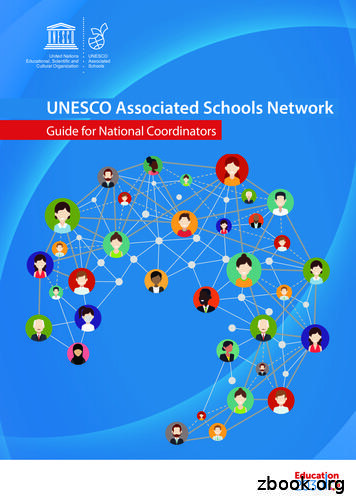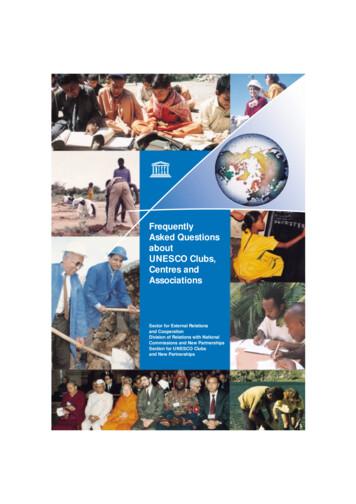SUVEY Of FORMAL EDUCATION - UNESCO UIS
INSTRUCTION MANUALSurvey of Formal EducationMontreal, February 20171
CONTENTCONTENT. 2Submission of questionnaires . 5Section 1. COVERAGE OF THE SURVEY . 6A. FORMAL INITIAL EDUCATION . 7B. FORMAL ADULT EDUCATION . 7C. SPECIAL NEEDS EDUCATION. 7D. VOCATIONAL EDUCATION . 8E. EDUCATION FINANCE AND EXPENDITURE . 8Section 2. REFERENCE PERIODS AND DATES . 9A. SCHOOL OR ACADEMIC YEAR . 9B. FINANCIAL YEAR . 9C. REFERENCE DATE FOR AGES . 9Section 3. CROSS-CUTTING CONCEPTS . 10A. LEVELS . 10B. LEVEL COMPLETION AND ACCESS . 11C. GRADES . 12D. FIELDS . 12E. ORIENTATION . 13F. FULL-TIME, PART-TIME AND FULL-TIME EQUIVALENTS (FTE) . 14Full-time and part-time students . 14Full-time and part-time teaching staff . 15Full-time equivalents (FTE) . 152
G. AGE . 16H. EDUCATIONAL INSTITUTIONS . 16Instructional and non-instructional . 16Public and private . 16I.RESOURCES AND INFRASTRUCTURE IN EDUCATIONAL INSTITUTIONS . 17Information and communication technology services and training . 17Drinking water and basic hygiene services . 18Adapted infrastructure and materials for students with disabilities . 19Life skills-based HIV and sexuality education . 19Section 4. STATISTICAL UNITS . 20A. STUDENTS . 20B. NEW ENTRANTS . 20New entrants to Grade 1 of primary education with prior experience of early childhoodeducation . 21First-time new entrants to tertiary education . 21C. REPEATERS . 21D. GRADUATES . 21E. INTERNATIONALLY MOBILE STUDENTS . 22F. TEACHING STAFF AND NON-TEACHING STAFF . 23Teaching staff . 23Non-teaching staff . 24Qualified teachers . 25Trained teachers . 25In-service teacher training . 25Teacher’s level of qualification. 25G. ANNUAL STATUTORY TEACHER COMPENSATION . 26H. REPORTING STATISTICAL UNITS BY CROSS-CUTTING CONCEPTS . 263
Teaching staff by level or orientation . 27Students or graduates by field . 27Students graduating from two or more programmes or levels . 27Educational institutions offering two or more programmes or levels . 27Section 5. EDUCATION FINANCE AND EXPENDITURE . 29A. EXPENDITURE FROM GOVERNMENT SOURCES . 30Levels of government . 30Destination of funds . 31Direct government expenditure for educational institutions . 31Intergovernmental transfers for education. 31Government transfers and payments for education to the private sector . 32B. EXPENDITURE FROM INTERNATIONAL SOURCES. 33Direct expenditure for educational institutions from international sources. 33Transfers from international sources to all levels of government . 33C. EXPENDITURE FROM PRIVATE SOURCES. 33Household expenditure on education. 33Expenditure of other non-educational private entities . 34D. EXPENDITURE BY NATURE IN EDUCATIONAL INSTITUTIONS. 35Current expenditure on education. 35Capital expenditure on education . 374
INTRODUCTIONThe objective of the UNESCO Institute for Statistics (UIS) Survey of Formal Education is toprovide internationally comparable data on key aspects of education systems, such as access,participation, progression and completion, as well as the associated human and financialresources dedicated to them.The data collected are used to monitor and report on international development goals related toeducation, including the education goal of the 2030 Agenda for Sustainable Development. Thesedata also form a central part of the UIS international database of education statistics which aredisseminated widely to the user community and help to inform policymakers at both the nationaland international levels.The survey collects information on formal education programmes only classified by level ofeducation as defined in the 2011 revision of the International Standard Classification ofEducation (ISCED 2011).The macro level data that are reported are usually provided by Ministries of Education or byNational Statistical Offices.This instruction manual has been prepared to help data providers in Member States completethe following questionnaires that comprise the Survey of Formal Education: UIS/E/A on students and teachers (ISCED 0-4); UIS/E/B on educational expenditure; and UIS/E/C on students and teachers (ISCED 5-8).Submission of questionnairesThe electronic questionnaires are available es/country.aspxCompleted questionnaires should be sent by email attachment to uis.survey@unesco.orgIf you experience problems accessing the site or for any questions related to the data collection,please contact the UIS at uis.survey@unesco.org or by telephone at 1 514 343 6880.5
Section 1. COVERAGE OF THE SURVEYThe survey collects data on formal education programmes that represent at least the equivalentof one semester (or one-half of a school/academic year) of full-time study and are provided withinthe reporting country’s own territory.Formal education is institutionalised, intentional and planned and provided by publicorganizations and recognised private bodies. It consists primarily of initial education designedfor children and young people before their first entry to the labour market. It also includes othertypes of education such as vocational, special needs and adult education provided they arerecognised as part of the formal education system by the relevant national education authorities.The data collection covers all of a country’s formal domestic educational activity (i.e. formaleducation provided within its own territory) regardless of ownership or sponsorship of theinstitutions concerned (whether public or private, national or foreign) or of the education deliverymechanism (whether face-to-face or at a distance).In particular, all students studying within the country, including internationally mobile studentsfrom abroad, should be included in the statistics of the reporting country. Students who have leftthe reporting country to study abroad should not be included even where such students arepartially- or fully-funded by national or sub-national authorities.By contrast, formal educational activities which take place abroad – for example, in institutionsrun by providers located in the reporting country or study abroad by students originating from thereporting country – should be excluded.The survey covers formal education which takes place entirely in educational institutions oris delivered as a combined school- and work-based programme providing the school-basedcomponent represents at least 10% of the study over the whole programme. Entirely workbased training is excluded. The programmes on which data should be reported in this surveyinclude:a.programmes representing at least one semester of full-time study;b.school-based or combined school- and work-based programmes;c.formal initial education in early childhood education programmes, pre-primary, primaryand secondary schools, colleges, polytechnics, universities and in other post-secondaryinstitutions;d.formal adult education recognised by the relevant national education authorities;e.vocational or technical education and special needs education;f.distance education (especially at the tertiary level);g.formal education in public (or state) and in private schools, colleges, polytechnics oruniversities;h.both full-time and part-time formal education; andi.education provided in the reporting country of all students whether citizens or noncitizens.6
The education programmes covered by the survey should be classified according to thelevels and fields of education respectively defined in the 2011 revision of the InternationalStandard Classification of Education (ISCED 2011) and the ISCED Fields of Education andTraining 2013 (ISCED-F 2013).The following is a set of basic definitions that helps to define the scope and coverage of thisdata collection.A.FORMAL INITIAL EDUCATIONFormal education is institutionalised, intentional and planned through public organizations andrecognised private bodies. Formal education programmes are thus recognised as such by therelevant national education authorities or equivalent authorities, e.g. any other institution incooperation with the national or sub-national education authorities. Formal education consistsmostly of initial education.Initial education is the education of individuals before their first entrance to the labour market,i.e. when they will normally be in full-time education. It thus targets individuals who areregarded as children, youth and young adults by their society. It typically takes place ineducational institutions in a system designed as a continuous educational pathway.B.FORMAL ADULT EDUCATIONAdult education is specifically targeted at individuals who are regarded as adults by theirsociety to improve their technical or professional qualifications, further develop their abilities,enrich their knowledge with the purpose to complete a level of formal education, or to acquire,refresh or update their knowledge, skills and competencies in a particular field. This alsoincludes what may be referred to as ‘continuing education’, ‘recurrent education’ or ‘secondchance education’.In most countries adult education is not recognised as part of the formal education systemand should therefore be excluded from this survey. Formal adult education programmesincluded in this data collection may be designed as second chance programmes for youthor adults and offered in the same or similar formal settings as initial education. They donot have the same typical entry age as equivalent programmes in initial education andmay have a different, usually shorter, duration.Formal adult education programmes should be assigned to the most appropriate ISCEDlevels. They should not be treated as a separate level of education.C.SPECIAL NEEDS EDUCATIONFormal special needs education is treated similarly to other initial educationprogrammes provided the main aim of these programmes is the educational developmentof the individual.7
Special needs education is designed to facilitate learning by individuals who, for a widevariety of reasons, require additional support and adaptive pedagogical methods in order toparticipate and meet learning objectives in an education programme.Programmes in special needs education may follow a similar curriculum to that offered inthe parallel regular education system (i.e. initial education designed for individuals withoutspecial educational needs), but they take individual needs into account by providing specificresources (e.g. specially-trained personnel, equipment or space) and, if appropriate, modifiededucational content or learning objectives. These programmes can be offered to individualstudents within already-existing education programmes or as a separate class in the same orseparate educational institutions.D.VOCATIONAL EDUCATIONFormal vocational education programmes are covered by this data collection providedthey are delivered either as entirely school-based programmes or as combined school- andwork- based programmes in which the school-based component represents at least 10% ofthe total study over the whole programme. Entirely work-based training is excluded.Vocational education is designed for learners to acquire the knowledge, skills andcompetencies specific to a particular occupation, trade, or class of occupations or trades.Vocational education may have work-based components. Successful completion of suchprogrammes leads to labour market-relevant vocational qualifications acknowledged asoccupationally-oriented by the relevant national authorities and/or the labour market.Experience shows that for combined school- and work-based programmes the coverage ofwork-based components in national data collections is uneven. In order to ensurecomparability across countries, the reporting of student numbers should fully includeparticipation in the work- based components, as part of combined or hybrid systems, whileteaching staff (or trainers) of this component should always be excluded. Similarly, thefinancing of work-based components should not be reported in education finance statistics.E.EDUCATION FINANCE AND EXPENDITUREThe data collection on education finance and expenditure covers government expenditureon formal education, including expenditure from all government ministries and agenciesfinancing or supporting education programmes. Where possible, it should also includeexpenditure from international and private sources.Data on education finance and expenditure should be reported for the same programmes asfor students, teaching staff and graduates. This means they should cover spending on formaleducation programmes which are delivered within the national territory, irrespective of thecitizenship of students enrolled in these programmes.Expenditure should be reported whether it is on instructional or non-instructionaleducational institutions, public or private.Expenditure on education includes expenditure on core educational goods and services,such as teaching staff, school buildings, or school books and teaching materials, andperipheral educational goods and services such as ancillary services, generaladministration and other activities.8
Section 2. REFERENCE PERIODS AND DATESA.SCHOOL OR ACADEMIC YEARThe start and end dates of the school or academic year should be reported separately for studentsand for graduates. The start date is the first day of the reference year the educational institutionwas open to provide instruction to students. The end date is the last day of formal instruction evenif the institution remains open for teachers or if examinations are being held. If data on graduatesare collected according to a different year from students (for example within a given calendar yearrather than school or academic year) the start and end dates of the data collection year should bereported.B.FINANCIAL YEARThe financial year is a 12-month period ending in the survey reference year during which theannual education budget is spent. It may or may not coincide with the school or academic year.C.REFERENCE DATE FOR AGESThe reference date for ages is the single date at which the ages of students are recorded.Where national data collection systems allow and to ensure cross-national comparability, thisdate should be as close as possible to the beginning of the reference school or academic year toenable the more accurate calculation of net enrolment rates and similar indicators.9
Section 3. CROSS-CUTTING CONCEPTSA.LEVELSThe data reported in this survey should be disaggregated by the levels of education defined inthe 2011 revision of the International Standard Classification
c. formal initial education in early childhood education programmes, pre-primary, primary and secondary schools, colleges, polytechnics, universities and in other post-secondary . refresh or update their knowledge,
The UNESCO -IHE Institute for Water Education (UNESCO -IHE) became part of the UNESCO Water Familyduring the 31 st session of the UNESCO General Conference in October 2001 and started its operations in June 2003. Before becoming a UNESCO Category I Institute, UNESCO -IHE
UNESCO Office, Jakarta Publications 2006-2007 UNESCO Office, Jakarta www.UNESCO.or.id Jl. Galuh II no 5. Kebayoran Baru. Jakarta 12110 Tel: 62-21 7399818. Fax: 62-21 72796489 Email: Jakarta@unesco.org UNESCO Librarian : Rosinta P. Hutauruk (rp.hutauruk@unesco.org ) Basic Sciences (BSC) -2007 / 2006 Coastal and Small Island -2007 / 2006
Designed and printed by UNESCO Printed in France UNESCO Education Sector Education is UNESCO’s top priority because it is a basic human right and the foundation on which to build peace and drive sustainable development. UNESCO is the United Nations’ specialized agency for education and the Education Sector provides global and
c. formal initial education in early childhood education programmes, pre-primary, primary and secondary schools, colleges, polytechnics, universities and in other post-secondary . refresh or update their knowledge,
4 Resolution 1.341, 7th session of the UNESCO General Conference, 1952 5 Document UNESCO/ED/149 of 4 February 1957 6 Document ED/MD/19, 1971 7 UNESCO's Associated Schools Project Network (ASPnet) - List of Participating Institutions, UNESCO 1997 8 Approved Programme and Budget for 1998-1999, Document 29 C/5, Paragraph 06028, UNESCO, 1998 1 1
This brochure was prepared collaboratively by colleagues from the UNESCO Education Sector, including from the Regional bureaux (Bangkok, Beirut, Dakar and Santiago) and the following institutes: UNESCO International Bureau of Education, UNESCO International Institute for Educational Planning, UNESCO
that appeal, the UNESCO Clubs movement gradually spread throughout the world. In 2001, there were more than 5,000 clubs* in more than 120 countries. *The term UNESCO Club is the one most frequently used, although several countries choose to call them UNESCO associations, centres, circles, or friends of UNESCO. They all refer to the same type of .
Archaeological Illustration ARCL0036 UCL - INSTITUTE OF ARCHAEOLOGY COURSE NUMBER: ARCL0036 Archaeological Finds Illustration 2018/2019 Year 2, 0.5 unit 15 Credits Co-ordinator: Stuart Laidlaw Co-ordinator's e-mail tcfasjl@ucl.ac.uk Co-ordinator's room number is 405 Telephone number 020 7679 4743 Internal 24743 The Turnitin 'Class ID' is 3884493 and the 'Class Enrolment Password' is IoA1819 .























